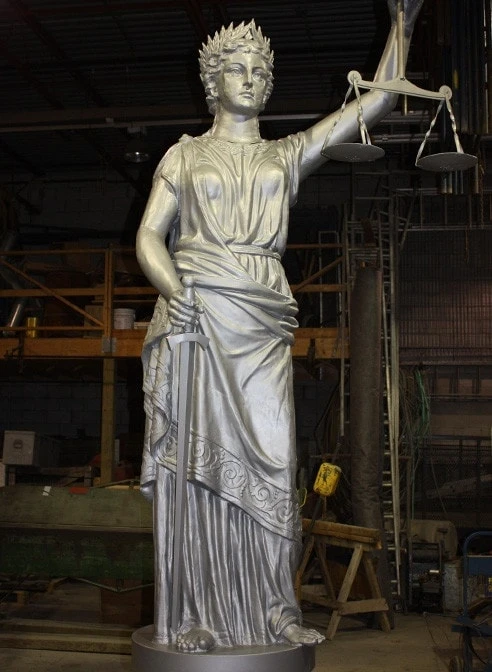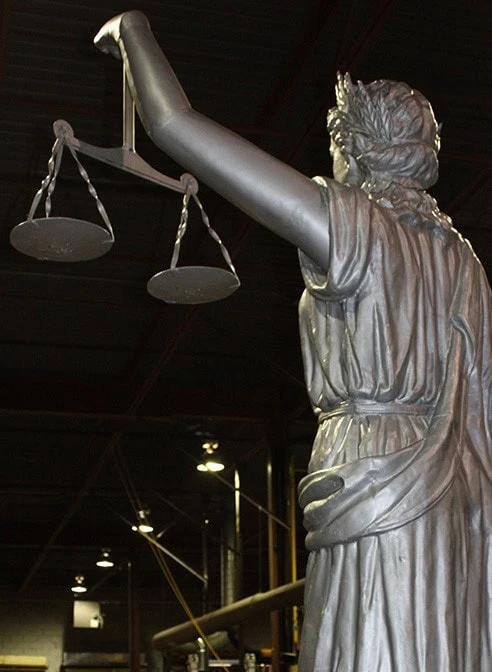Artwork depicting the Lady of Justice statue, whether in the form of paintings, sculptures, coats of arms or metal statues, is found throughout the world. If you’re in North or South America, Europe, Africa, the Middle East, Southern and Eastern Asia, and Australasia, you will likely see the Lady of Justice statue in courthouses, law offices and legal, and educational institutions. The history of the Lady Justice statue goes back many thousands of years, and she typically carries symbols of justice.

The History of Lady Justice
The concept of Lady Justice is very old, dating back to ancient Greek and Egyptian times. Themis, the Greek goddess, represented law, order, and justice, while the Egyptians had Ma’at, who stood for order and carried both a sword and the Feather of Truth. The most direct comparison, however, is with the Roman goddess of justice, Justitia.
What Does She Look Like?
The Lady Justice statue is usually in the form of a woman who is standing or sitting. She is typically dressed in a toga-like robe, maybe barefoot, and her hair is either flowing over her shoulders or braided in a bun or around her head. She holds a balance, or two-tray scale in one hand and a sword in the other; usually, the scales are in the left hand and the sword in the right, but this is not always so. Sometimes, she also wears a blindfold over her eyes.
Origins of the Lady Justice Statue
Some of the first images similar to the Lady of Justice date back to the Egyptian goddess Maat, who signified truth and order in that ancient society. Later, the ancient Greeks worshipped the goddess Themis, the personification of divine law and custom, and her daughter, Dike, whose name means "justice." Dike was always depicted carrying a pair of balance scales, and it was believed that she ruled over human law.
The ancient Romans revered Justitia or lustitia, who most closely resembles the Lady of Justice statues formed in more modern times. She represented the morality of the justice system.
The Symbols of Justice
Balance Scales: These represent impartiality and the obligation of the law (through its representatives) to weigh the evidence presented to the court. Each side of a legal case needs to be looked at, and comparisons made as justice is done.

Sword: This item symbolizes enforcement and respect and means that justice stands by its decision and ruling and is able to take action. The fact that the sword is unsheathed and very visible is a sign that justice is transparent and is not an implement of fear. A double-edged blade signifies that justice can rule against either of the parties once the evidence has been perused, and it is bound to enforce the ruling as well as protect or defend the innocent party.
Blindfold: This first appeared on a Lady Justice statue in the 16th century and has been used intermittently since then. Apparently, its original significance was that the judicial system was tolerating abuse or ignorance of aspects of the law. However, in modern times, the blindfold represents the impartiality and objectivity of the law and that it doesn't let outside factors, such as politics, wealth or fame, influence its decisions.
Restoration of Lady of Justice Statues
Because many Lady Justice statues in North America were constructed and put in place during the late 1800s and early 1900s, they have suffered extreme weathering or were even taken down and misplaced. Heather & Little successfully and carefully performed statue restoration services or replaced a number of Lady of Justice statues, including one at Navarro County Courthouse in Corsicana, Texas, and another at Milam County Court House in Cameron, Texas, both of sheet copper. Sheet zinc was used to repair the Lady Justice statue at Edgar County Court House in Paris, Illinois.
Contact us today for statue restoration services and more
Find out more about Heather & Little's statue restoration and how we can help you re-create or repair new or historic roofs, domes, cupolas, cornices and metal statues like the lady of Justice.
Contact us online today or call (866) 460-6839 to get a quote.
If you are looking for a second opinion on your project or have a particularly complex issue that needs a fresh eye, such as historic building restoration, we’re here to help. Tackling tricky restoration projects is our specialty, and we welcome the opportunity to provide consulting services. We apply a keen attention to detail to all our commissions.
Join our mailing list and keep up to date on what’s going on with Heather & Little, sheet metal and roofing, including access to industry insights, interesting project case studies and incentives.